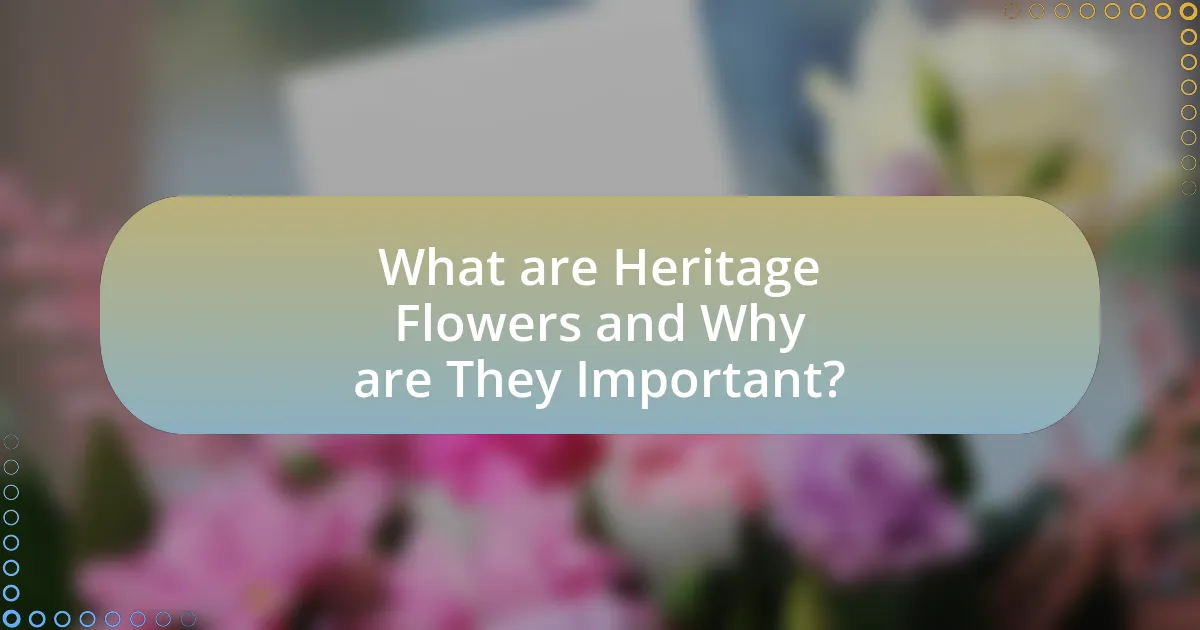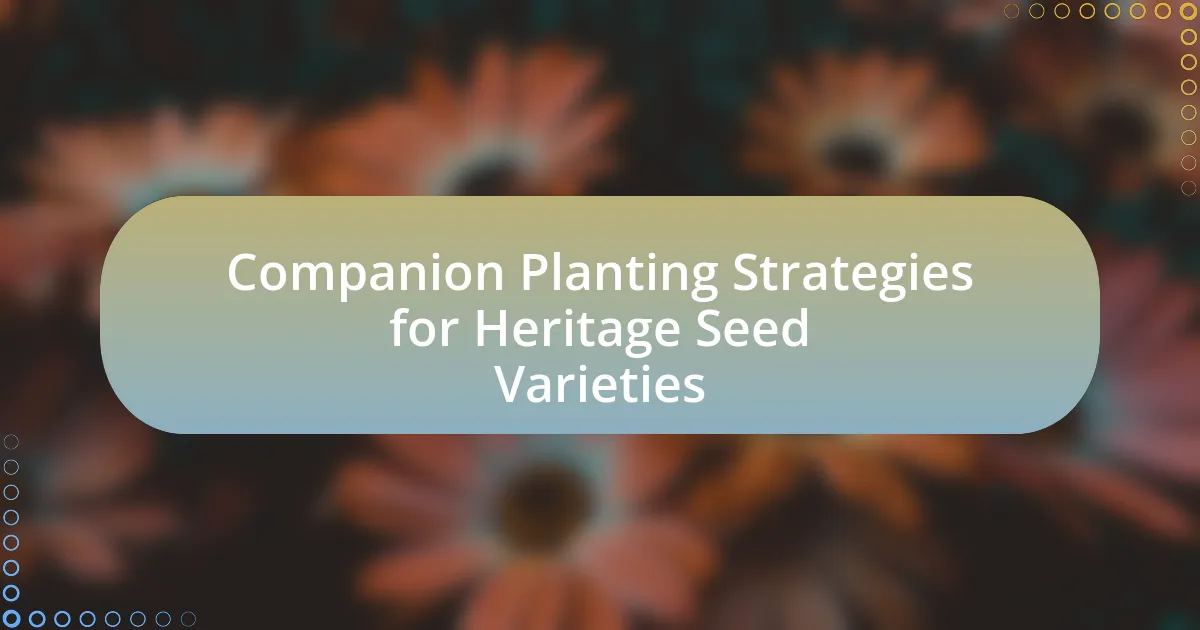Heritage flowers are traditional plant varieties cultivated for generations, valued for their historical significance, genetic diversity, and adaptability to local environments. This article outlines best practices for propagating these flowers, emphasizing methods such as seed propagation, division, and cuttings, while highlighting the importance of optimal environmental conditions, soil quality, and pest management. Key benefits of propagating heritage flowers include preserving genetic diversity, enhancing cultural heritage, and contributing to biodiversity, making them essential for sustainable gardening practices. The article also addresses common challenges in propagation and offers troubleshooting tips to ensure successful growth and reproduction of these valuable plants.

What are Heritage Flowers and Why are They Important?
Heritage flowers are traditional plant varieties that have been cultivated for generations, often valued for their historical significance, unique characteristics, and adaptability to local environments. These flowers are important because they contribute to biodiversity, preserve cultural heritage, and support sustainable gardening practices. For instance, many heritage flowers are more resilient to pests and diseases compared to modern hybrids, which can lead to reduced reliance on chemical treatments. Additionally, they often have historical ties to specific regions or communities, fostering a sense of identity and continuity.
How do Heritage Flowers differ from Modern Varieties?
Heritage flowers differ from modern varieties primarily in their genetic diversity and historical significance. Heritage flowers, often referred to as heirloom varieties, have been cultivated for generations and typically exhibit a wider range of colors, shapes, and fragrances due to their open-pollinated nature, which allows for natural crossbreeding. In contrast, modern varieties are frequently hybridized for specific traits such as uniformity, disease resistance, and extended shelf life, often resulting in reduced genetic diversity. For example, many heritage roses have unique scents and complex petal structures that are less common in modern hybrids, which are bred primarily for visual appeal and commercial viability. This distinction highlights the importance of preserving heritage flowers for their ecological and cultural value.
What characteristics define Heritage Flowers?
Heritage flowers are characterized by their historical significance, genetic diversity, and traditional cultivation methods. These flowers often originate from specific regions and have been passed down through generations, preserving unique traits that are not commonly found in modern hybrids. For example, many heritage flowers are known for their resilience to local pests and diseases, as they have adapted to their environments over time. Additionally, they typically exhibit a wide range of colors, shapes, and fragrances, which contribute to their appeal in gardens and landscapes. The preservation of these flowers is crucial for maintaining biodiversity and cultural heritage in horticulture.
Why is genetic diversity important in Heritage Flowers?
Genetic diversity is crucial in Heritage Flowers because it enhances resilience to diseases, pests, and environmental changes. A diverse genetic pool allows for a wider range of traits that can adapt to varying conditions, ensuring the survival and sustainability of these plants. For instance, studies have shown that populations with higher genetic diversity are more likely to withstand stressors, such as climate fluctuations, compared to those with limited genetic variation. This adaptability is essential for maintaining the integrity and longevity of Heritage Flowers, which often have historical and cultural significance.
What are the benefits of propagating Heritage Flowers?
Propagating Heritage Flowers offers several benefits, including the preservation of genetic diversity and the maintenance of historical plant varieties. By propagating these flowers, gardeners can ensure the survival of unique traits that may be lost in modern hybrids. Additionally, Heritage Flowers often have better adaptability to local climates and soil conditions, making them more resilient and easier to grow. Studies have shown that these plants can contribute to biodiversity, which is crucial for ecosystem health. Furthermore, propagating Heritage Flowers can enhance cultural heritage by keeping traditional gardening practices alive, fostering a connection to history and community.
How do Heritage Flowers contribute to biodiversity?
Heritage flowers contribute to biodiversity by preserving genetic diversity and supporting local ecosystems. These flowers often represent heirloom varieties that have adapted to specific regional conditions, thus maintaining a wider range of genetic traits that can enhance resilience against pests and diseases. For example, studies have shown that cultivating heritage varieties can increase pollinator populations, as these plants often provide unique resources that modern hybrids do not. Additionally, heritage flowers can help sustain traditional agricultural practices, which further promotes biodiversity by maintaining diverse plant communities and soil health.
What cultural significance do Heritage Flowers hold?
Heritage flowers hold significant cultural importance as they often represent historical traditions, regional identities, and ancestral connections. These flowers are frequently associated with specific cultural practices, such as festivals, rituals, and ceremonies, which help preserve the heritage of communities. For instance, the use of heritage flowers in traditional gardens reflects the agricultural practices and aesthetic values of past generations, thereby fostering a sense of continuity and belonging. Additionally, many heritage flowers have been cultivated for centuries, embodying the stories and experiences of the people who have tended to them, thus serving as living symbols of cultural heritage.

What are the Best Methods for Propagating Heritage Flowers?
The best methods for propagating heritage flowers include seed propagation, division, and cuttings. Seed propagation allows for the reproduction of specific flower traits, while division involves separating established plants into smaller sections, promoting growth and maintaining genetic integrity. Cuttings, taken from healthy parent plants, can root and develop into new plants, preserving the characteristics of the heritage variety. These methods are widely recognized for their effectiveness in maintaining the unique qualities of heritage flowers, ensuring their continued cultivation and appreciation.
How can seeds be effectively used for propagation?
Seeds can be effectively used for propagation by ensuring proper selection, preparation, and environmental conditions. Selecting high-quality seeds from heritage flowers is crucial, as these seeds often retain the genetic traits of the original plants. Preparing seeds may involve scarification or stratification to enhance germination rates, as some seeds require specific treatments to break dormancy. Providing optimal environmental conditions, such as appropriate soil type, moisture levels, and temperature, is essential for successful germination and growth. Research indicates that seeds of heritage flowers can have germination rates exceeding 80% when these practices are followed, demonstrating their effectiveness in propagation.
What steps should be taken to collect and store seeds?
To collect and store seeds, first, ensure that seeds are harvested at the right time, which is typically when they are fully mature and dry. This can be determined by observing the plant; seeds should be collected when seed pods or heads are brown and dry. Next, gently remove the seeds from the plant, taking care to avoid damage. After collection, clean the seeds by removing any debris or plant material, which helps prevent mold during storage.
For storage, place the seeds in a cool, dry environment, ideally in airtight containers such as glass jars or sealed envelopes to protect them from moisture and pests. Label each container with the seed type and collection date for easy identification. Properly stored seeds can remain viable for several years, with some studies indicating that certain seeds can last up to 10 years or more when stored correctly.
How can seed germination be optimized for Heritage Flowers?
Seed germination for Heritage Flowers can be optimized by implementing stratification and ensuring proper soil conditions. Stratification involves exposing seeds to a period of cold and moisture, mimicking natural winter conditions, which is essential for many Heritage Flower species to break dormancy. Additionally, using well-draining soil with a balanced pH and maintaining consistent moisture levels without waterlogging can significantly enhance germination rates. Research indicates that seeds of certain Heritage Flowers, such as those from the Asteraceae family, benefit from these practices, leading to improved germination success and healthier seedlings.
What role do cuttings play in propagating Heritage Flowers?
Cuttings are a crucial method for propagating Heritage Flowers, as they allow for the asexual reproduction of plants, preserving their genetic traits. By taking a section of a stem, leaf, or root from a parent plant, gardeners can create new plants that are genetically identical to the original. This method is particularly important for Heritage Flowers, which often have unique characteristics and historical significance that gardeners wish to maintain. Research indicates that using cuttings can lead to faster establishment and flowering compared to seed propagation, making it an efficient choice for preserving these valuable plants.
What types of cuttings are most effective for different species?
Softwood cuttings are most effective for propagating species like roses and hydrangeas, while semi-hardwood cuttings work well for plants such as camellias and azaleas. Hardwood cuttings are ideal for species like lilacs and forsythias. Research indicates that softwood cuttings taken in late spring to early summer have higher success rates due to the active growth phase of these plants, with studies showing rooting success rates of up to 80% for roses when using this method. Semi-hardwood cuttings, taken in late summer to early fall, typically yield rooting success rates of around 60% for camellias. Hardwood cuttings, taken during dormancy in late fall or winter, can achieve rooting rates of approximately 50% for lilacs, demonstrating the effectiveness of matching cutting types to specific plant species and their growth cycles.
How can the success rate of cuttings be improved?
To improve the success rate of cuttings, ensure optimal environmental conditions, including humidity, temperature, and light. Research indicates that maintaining high humidity levels around cuttings can significantly enhance root development, as evidenced by a study published in the Journal of Horticultural Science, which found that cuttings in a humidity-controlled environment had a 30% higher rooting success rate compared to those in standard conditions. Additionally, using rooting hormones can stimulate faster root growth, further increasing the likelihood of successful propagation.

What Environmental Factors Affect the Propagation of Heritage Flowers?
Environmental factors that affect the propagation of heritage flowers include soil quality, temperature, humidity, and light exposure. Soil quality influences nutrient availability and drainage, which are critical for root development; for instance, well-drained, loamy soil promotes healthy growth. Temperature affects germination rates and flowering times; many heritage flowers thrive in specific temperature ranges, typically between 60°F and 75°F. Humidity levels impact water retention in the soil and plant transpiration; higher humidity can benefit certain species that require moist conditions. Lastly, light exposure is essential for photosynthesis; most heritage flowers prefer full sun, which generally means at least six hours of direct sunlight daily. These factors collectively determine the success of propagating heritage flowers in various environments.
How does soil quality impact Heritage Flower propagation?
Soil quality significantly impacts Heritage Flower propagation by influencing nutrient availability, water retention, and microbial activity. High-quality soil, rich in organic matter and well-drained, promotes healthy root development and enhances the plant’s ability to absorb essential nutrients. For instance, studies show that soil with a balanced pH and adequate levels of nitrogen, phosphorus, and potassium leads to improved germination rates and stronger seedlings. Additionally, healthy soil supports beneficial microorganisms that can protect against diseases, further ensuring successful propagation of Heritage Flowers.
What soil amendments are beneficial for Heritage Flowers?
Organic matter, such as compost and well-rotted manure, is beneficial for Heritage Flowers. These soil amendments improve soil structure, enhance nutrient availability, and promote beneficial microbial activity. Research indicates that compost can increase soil fertility and water retention, which are crucial for the healthy growth of Heritage Flowers. Additionally, incorporating bone meal provides essential phosphorus, supporting root development and flowering.
How can soil pH be adjusted for optimal growth?
Soil pH can be adjusted for optimal growth by adding lime to raise pH or sulfur to lower pH. Lime, primarily calcium carbonate, increases soil pH, making it less acidic, which is beneficial for plants that thrive in neutral to alkaline conditions. Conversely, elemental sulfur or aluminum sulfate can be applied to decrease soil pH, enhancing conditions for acid-loving plants. Research indicates that a pH range of 6.0 to 7.0 is generally optimal for most heritage flowers, as it allows for better nutrient availability and microbial activity in the soil.
What climatic conditions are ideal for Heritage Flower propagation?
The ideal climatic conditions for Heritage Flower propagation include moderate temperatures, adequate sunlight, and well-drained soil. Specifically, temperatures between 60°F to 75°F (15°C to 24°C) promote optimal growth, while full sun exposure for at least six hours a day enhances flowering and overall health. Additionally, maintaining soil moisture without waterlogging is crucial, as Heritage Flowers thrive in environments that prevent root rot. These conditions are supported by horticultural studies indicating that temperature and light significantly influence the germination and growth rates of flowering plants.
How do temperature and humidity influence growth rates?
Temperature and humidity significantly influence growth rates by affecting physiological processes in plants. Optimal temperature ranges promote enzymatic activity and metabolic functions, while excessive heat can lead to stress and reduced growth. For instance, many flowering plants thrive at temperatures between 20°C and 25°C, where photosynthesis and respiration rates are maximized. Humidity levels also play a crucial role; higher humidity can enhance transpiration and nutrient uptake, while low humidity may cause water stress and hinder growth. Research indicates that relative humidity levels between 50% and 70% are ideal for many heritage flowers, as they support healthy growth and flowering.
What seasonal considerations should be taken into account?
Seasonal considerations for propagating heritage flowers include understanding the optimal planting times, temperature fluctuations, and moisture levels. For instance, many heritage flowers thrive when planted in early spring or fall, as these seasons provide moderate temperatures and adequate rainfall, which are crucial for seed germination and root establishment. Additionally, specific flowers may require winter stratification or summer dormancy, making it essential to align propagation efforts with their natural growth cycles. Research indicates that planting during these optimal seasons can enhance survival rates and overall plant health, thereby ensuring successful propagation of heritage flowers.
What are some common challenges in propagating Heritage Flowers?
Common challenges in propagating Heritage Flowers include genetic variability, susceptibility to diseases, and specific environmental requirements. Genetic variability can lead to inconsistent growth patterns and flower characteristics, making it difficult to achieve uniformity in propagation. Additionally, many Heritage Flowers are prone to diseases that can affect their viability, such as fungal infections or pests, which can hinder successful propagation. Furthermore, these flowers often have specific environmental needs, such as particular soil types, moisture levels, and light conditions, which must be meticulously managed to ensure successful growth and reproduction.
How can pests and diseases be managed effectively?
Pests and diseases can be managed effectively through integrated pest management (IPM) strategies, which combine biological, cultural, mechanical, and chemical controls. IPM emphasizes monitoring pest populations and disease symptoms to make informed decisions about interventions. For instance, introducing beneficial insects like ladybugs can naturally reduce pest populations, while crop rotation and proper sanitation practices can minimize disease spread. Research indicates that IPM can reduce pesticide use by up to 50%, demonstrating its effectiveness in sustainable agriculture.
What troubleshooting tips can help overcome propagation failures?
To overcome propagation failures, ensure optimal environmental conditions such as temperature, humidity, and light. These factors significantly influence the success of plant propagation; for instance, many heritage flowers thrive in temperatures between 65°F and 75°F with high humidity levels. Additionally, using sterile tools and media can prevent disease, which is a common cause of propagation failure. Research indicates that pathogens can reduce rooting success by up to 50%, highlighting the importance of sanitation. Regularly monitoring moisture levels in the soil or propagation medium is also crucial, as both overwatering and underwatering can lead to root rot or desiccation, respectively.
What are the best practices for successful Heritage Flower propagation?
The best practices for successful Heritage Flower propagation include selecting healthy parent plants, using appropriate propagation methods such as seed sowing or cuttings, and ensuring optimal environmental conditions. Healthy parent plants provide robust genetic material, while methods like seed sowing allow for genetic diversity, and cuttings ensure the preservation of specific traits. Optimal conditions involve maintaining suitable moisture levels, temperature, and light exposure, which are critical for germination and root development. Research indicates that maintaining a controlled environment can increase success rates in propagation, with studies showing that specific humidity and temperature ranges significantly enhance seed germination and root establishment in various flower species.





